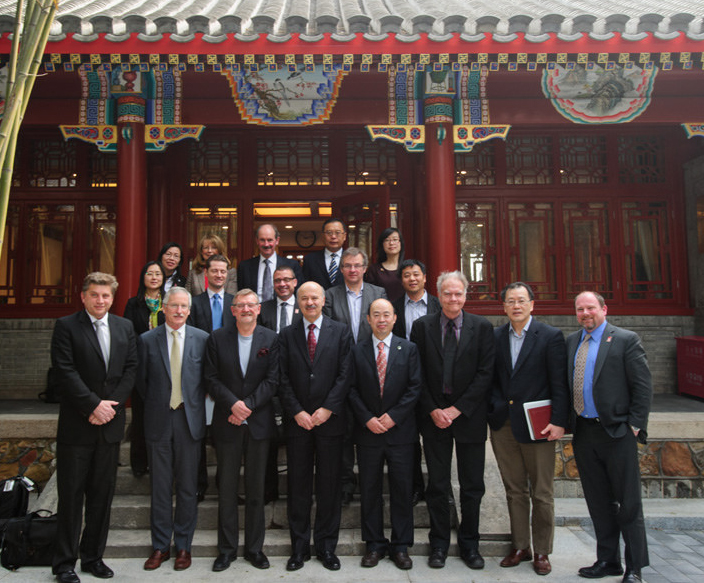A collaborative approach to advance stem cell research and commercialization
There is a Chinese proverb, 众人拾柴火焰高, that translates to “Only when all contribute their firewood can they build up a strong fire.” It summarizes an approach to collaboration that has been embraced by stem cell researchers in China, much like their Canadian counterparts.
 This affinity towards collaboration led to the 2013 formation of the Ontario-China Stem Cell Research and Commercialization Partnership between the Ontario Stem Cell Initiative (now the Ontario Institute for Regenerative Medicine; OIRM) and stem cell researchers based in Beijing and Guangzhou. Following this, two additional meetings have been convened in China: one in March 2014, and the second just last month.
This affinity towards collaboration led to the 2013 formation of the Ontario-China Stem Cell Research and Commercialization Partnership between the Ontario Stem Cell Initiative (now the Ontario Institute for Regenerative Medicine; OIRM) and stem cell researchers based in Beijing and Guangzhou. Following this, two additional meetings have been convened in China: one in March 2014, and the second just last month.
Twelve delegates from Ontario, representing OIRM and its commercialization partner, the Centre for Commercialization of Regenerative Medicine, visited Guangzhou at the end of May for two days of talks and meetings with their Chinese hosts. The goal of this meeting was to focus on strengthening the Partnership and sharing knowledge in areas of mutual research and commercial interest.
“Canadian researchers have a long history of collaboration in stem cell research with international partners” said Janet Rossant, OIRM executive director. “We are excited about the excellence of stem cell research in China and the reciprocity and openness we are seeing has led to some very quick and promising steps forward.”
Already, the concerted efforts of this new Partnership are beginning to bear fruit. In April, the first collaborative research paper authored by members of the Ontario-China Partnership was published in the Journal of Immunology. The paper reports new findings that confirm the advantage of mesenchymal/stromal cells (MSCs) as a therapeutic target in immune disorders. It also provides increased understanding of the role of MSCs in the development of dendritic cells, a cell in the blood system that serves as the interface between our bodies and the environment by carrying messages to activate immune cells when necessary. In a mouse model of irritable bowel disease, the team was able to show that MSCs used to create regulatory dendritic cells were able to alleviate colitis, making the approach relevant for future study in the treatment of immune disorders and organ transplant. The Ontario contribution to the research was led by Dr. Armand Keating at the University of Toronto.
Blood development, expansion and transplantation is a Canadian strength in stem cell research and was one of three areas that were identified as main projects of the Ontario-China Partnership. Other areas of research interest that were selected for collaborative study were pluripotency, reprogramming and stem cell banking, in which specific disease lines will be created and banked for further study, and stem cell differentiation to endoderm/pancreatic lineages, which aims to enable more efficient drug screening for a range of diseases associated with defects in the pancreas, liver, lungs and stomach.
Another key theme of the discussions is the commercialization of cell therapies, products and technologies. Reciprocal access to N. American and Asian markets would benefit both Ontario-based and Chinese companies. Enhanced integration of commercialization at the international level will also help ensure compatible standards for processes such as cell production and quality control, which will be increasingly necessary as more and more regenerative medicine therapies are implemented in the clinic.
Specifically, the Partnership seeks to expand receptor capacity and market pull for early-stage discoveries, including:
- Leveraging of resources and bundling of technologies;
- Job and company creation; and
- Access to global markets: mid-level (Ontario) and mass-market (China and North America).
“The translational and commercialization focus of our meeting is extremely important in realizing our long term goal of delivering new cell therapies,” said Rossant. “There are many advantages for both Chinese and Canadian companies. For example, our discussions with one of the major tissue engineering companies in China, based in Guangzhou, are ongoing with regard to possible reciprocal licensing opportunities.”
But the sharing also extends beyond formal meetings. During the 2014 workshop, Yang Li, an early career research associate in Hongkui Deng’s lab was excited by a talk by Juan Carlos Zuniga-Pflucker and applied for a postdoc position in Zuniga-Pflucker’s Toronto lab. As Li described it, “At this meeting, I met Juan Carlos and listened to his nice talk. I was very interested in his research about T-cell differentiation. It had been my dream to go abroad for academic training… Now I have worked with Juan Carlos for about eight months. During this period, I have learned many techniques and much knowledge about T-cell development… In the future, I will go back to Peking University [and] I hope I can use the knowledge and techniques learned from Canada to set up my own research direction.”
As the collaboration proverb suggests, each of these meetings, along with continued correspondence and sharing of personnel, data and knowledge is akin to another stick for the fire. With the current momentum of the Ontario-China Partnership, we can expect a strong fire that will burn for many years to come.
